Energy Resource Management and Regulations: COP21 & UK Policies
VerifiedAdded on 2020/04/13
|14
|3397
|38
Report
AI Summary
This report examines the management and regulation of energy resources, focusing on the UK's strategies to meet the objectives of the Paris Agreement (COP21). It analyzes stakeholder roles, including the government, industries, and employees, in achieving low carbon emissions and keeping global temperature rise below 2°C. The report explores factors affecting energy availability, such as supply chain management, demand, transportation, and geographical constraints. It also addresses the impact of these factors on rising energy demand, allocation strategies, and the role of technological advancements in energy management. Furthermore, the report evaluates the barriers to achieving the INDC targets set by COP21, particularly within sectors like aviation and agriculture, and emphasizes the need for efficient strategies and renewable energy sources. The report concludes with a discussion on the socioeconomic impacts and the importance of stakeholder collaboration in achieving sustainable energy practices.
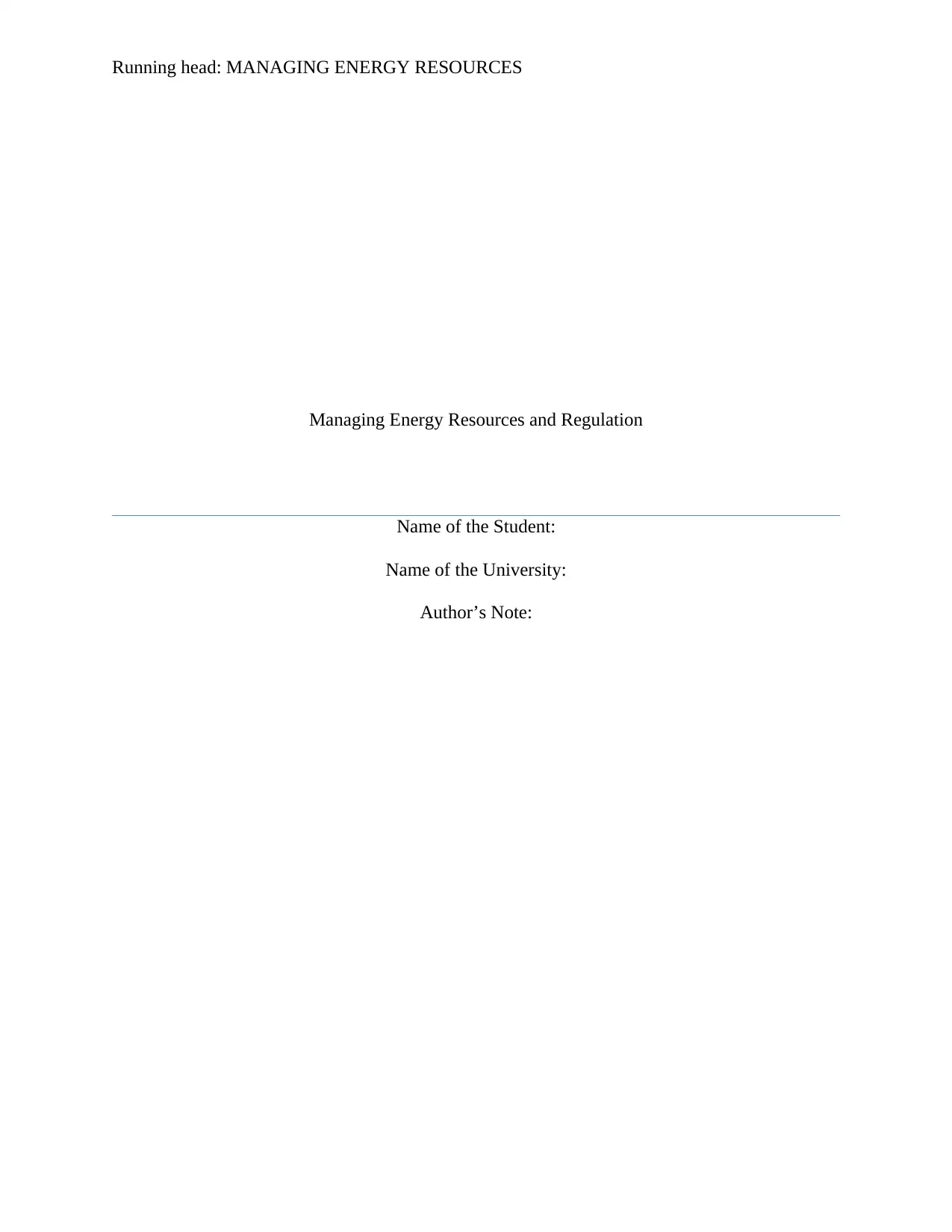
Running head: MANAGING ENERGY RESOURCES
Managing Energy Resources and Regulation
Name of the Student:
Name of the University:
Author’s Note:
Managing Energy Resources and Regulation
Name of the Student:
Name of the University:
Author’s Note:
Secure Best Marks with AI Grader
Need help grading? Try our AI Grader for instant feedback on your assignments.
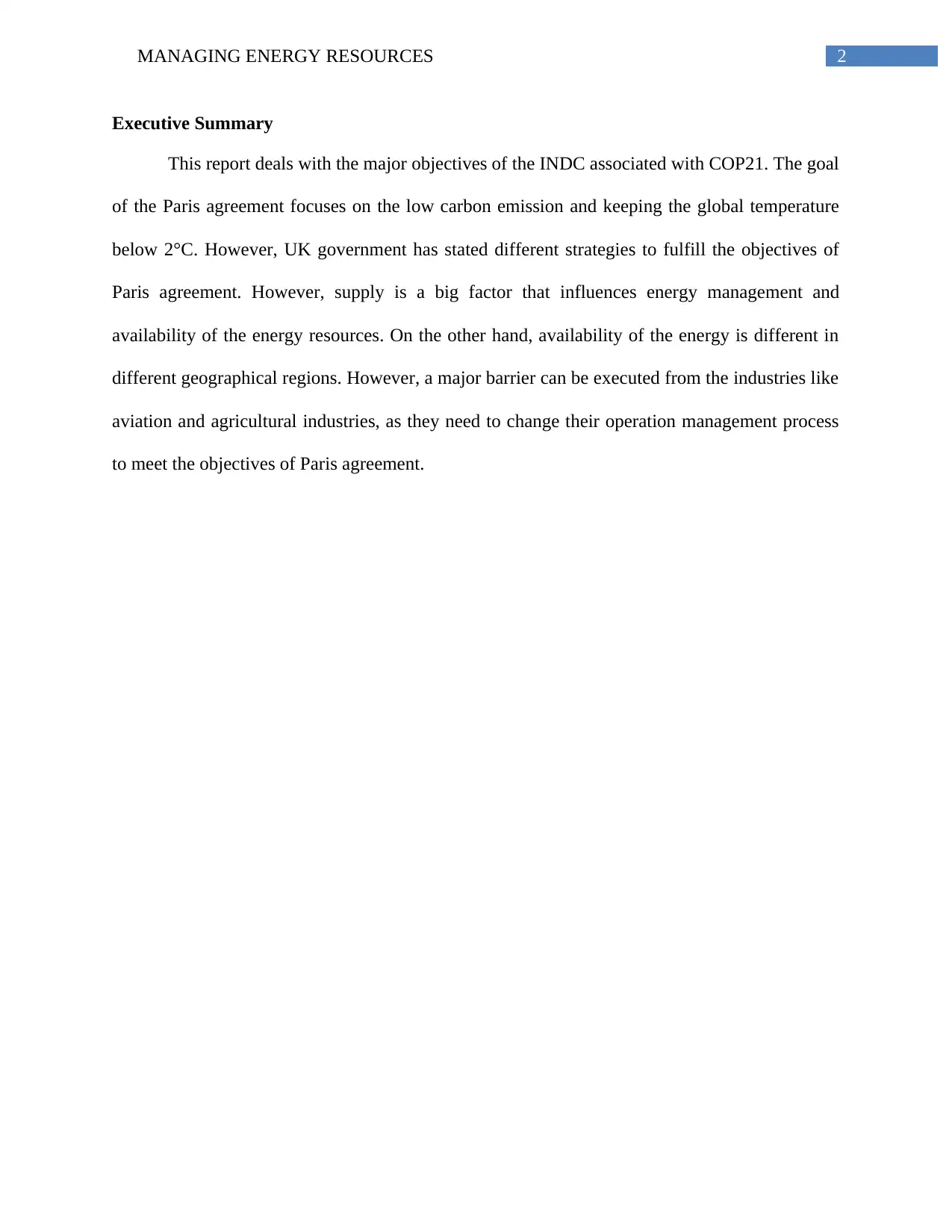
2MANAGING ENERGY RESOURCES
Executive Summary
This report deals with the major objectives of the INDC associated with COP21. The goal
of the Paris agreement focuses on the low carbon emission and keeping the global temperature
below 2°C. However, UK government has stated different strategies to fulfill the objectives of
Paris agreement. However, supply is a big factor that influences energy management and
availability of the energy resources. On the other hand, availability of the energy is different in
different geographical regions. However, a major barrier can be executed from the industries like
aviation and agricultural industries, as they need to change their operation management process
to meet the objectives of Paris agreement.
Executive Summary
This report deals with the major objectives of the INDC associated with COP21. The goal
of the Paris agreement focuses on the low carbon emission and keeping the global temperature
below 2°C. However, UK government has stated different strategies to fulfill the objectives of
Paris agreement. However, supply is a big factor that influences energy management and
availability of the energy resources. On the other hand, availability of the energy is different in
different geographical regions. However, a major barrier can be executed from the industries like
aviation and agricultural industries, as they need to change their operation management process
to meet the objectives of Paris agreement.
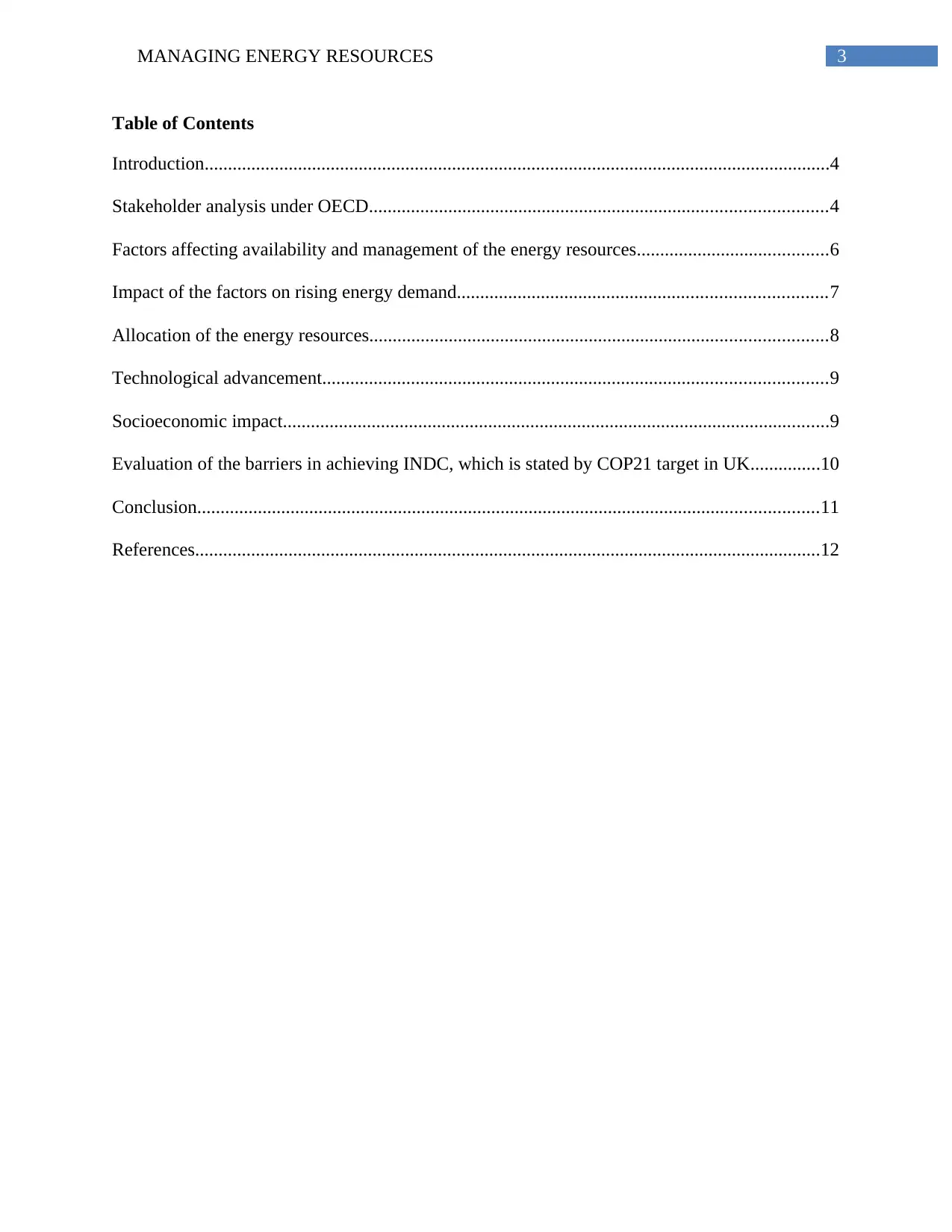
3MANAGING ENERGY RESOURCES
Table of Contents
Introduction......................................................................................................................................4
Stakeholder analysis under OECD..................................................................................................4
Factors affecting availability and management of the energy resources.........................................6
Impact of the factors on rising energy demand...............................................................................7
Allocation of the energy resources..................................................................................................8
Technological advancement............................................................................................................9
Socioeconomic impact.....................................................................................................................9
Evaluation of the barriers in achieving INDC, which is stated by COP21 target in UK...............10
Conclusion.....................................................................................................................................11
References......................................................................................................................................12
Table of Contents
Introduction......................................................................................................................................4
Stakeholder analysis under OECD..................................................................................................4
Factors affecting availability and management of the energy resources.........................................6
Impact of the factors on rising energy demand...............................................................................7
Allocation of the energy resources..................................................................................................8
Technological advancement............................................................................................................9
Socioeconomic impact.....................................................................................................................9
Evaluation of the barriers in achieving INDC, which is stated by COP21 target in UK...............10
Conclusion.....................................................................................................................................11
References......................................................................................................................................12
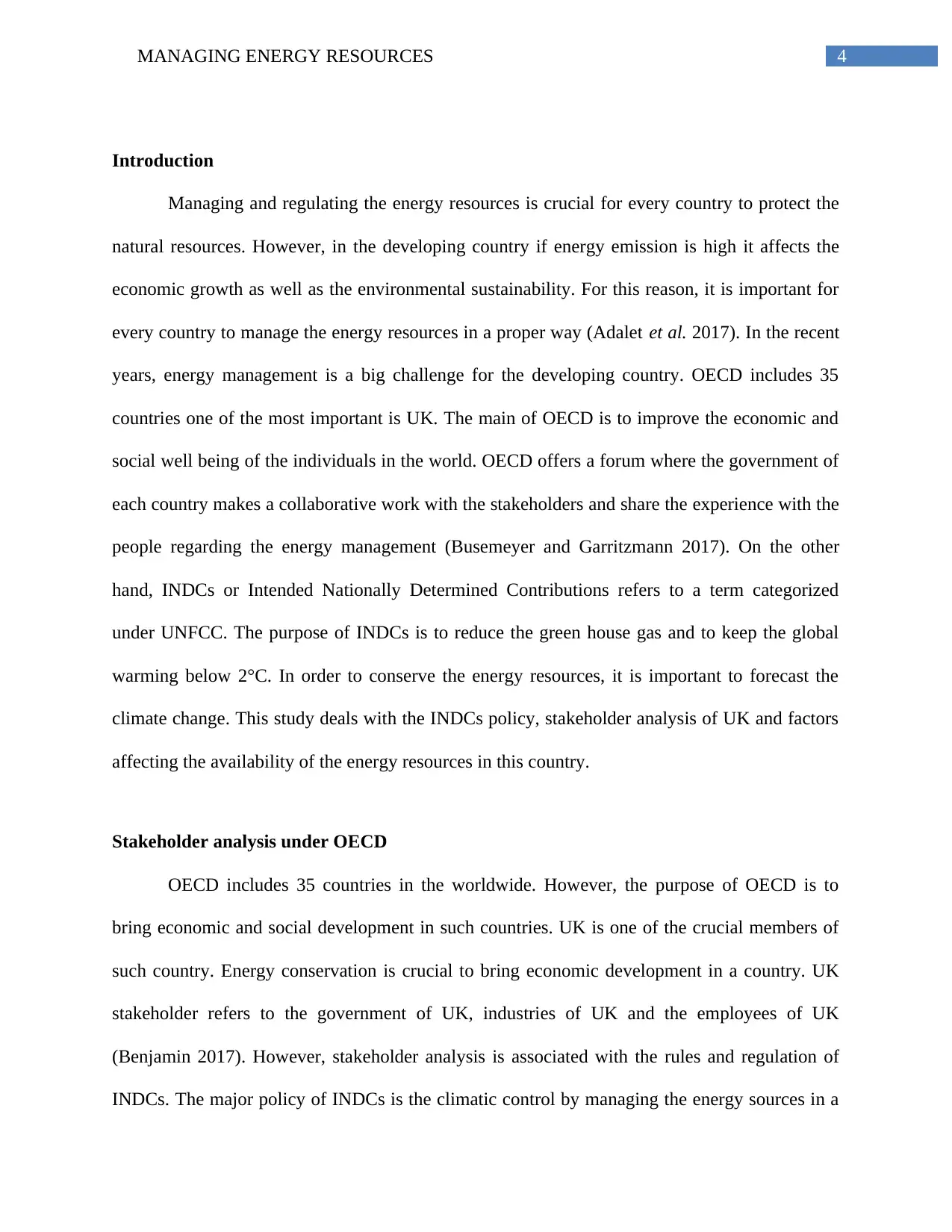
4MANAGING ENERGY RESOURCES
Introduction
Managing and regulating the energy resources is crucial for every country to protect the
natural resources. However, in the developing country if energy emission is high it affects the
economic growth as well as the environmental sustainability. For this reason, it is important for
every country to manage the energy resources in a proper way (Adalet et al. 2017). In the recent
years, energy management is a big challenge for the developing country. OECD includes 35
countries one of the most important is UK. The main of OECD is to improve the economic and
social well being of the individuals in the world. OECD offers a forum where the government of
each country makes a collaborative work with the stakeholders and share the experience with the
people regarding the energy management (Busemeyer and Garritzmann 2017). On the other
hand, INDCs or Intended Nationally Determined Contributions refers to a term categorized
under UNFCC. The purpose of INDCs is to reduce the green house gas and to keep the global
warming below 2°C. In order to conserve the energy resources, it is important to forecast the
climate change. This study deals with the INDCs policy, stakeholder analysis of UK and factors
affecting the availability of the energy resources in this country.
Stakeholder analysis under OECD
OECD includes 35 countries in the worldwide. However, the purpose of OECD is to
bring economic and social development in such countries. UK is one of the crucial members of
such country. Energy conservation is crucial to bring economic development in a country. UK
stakeholder refers to the government of UK, industries of UK and the employees of UK
(Benjamin 2017). However, stakeholder analysis is associated with the rules and regulation of
INDCs. The major policy of INDCs is the climatic control by managing the energy sources in a
Introduction
Managing and regulating the energy resources is crucial for every country to protect the
natural resources. However, in the developing country if energy emission is high it affects the
economic growth as well as the environmental sustainability. For this reason, it is important for
every country to manage the energy resources in a proper way (Adalet et al. 2017). In the recent
years, energy management is a big challenge for the developing country. OECD includes 35
countries one of the most important is UK. The main of OECD is to improve the economic and
social well being of the individuals in the world. OECD offers a forum where the government of
each country makes a collaborative work with the stakeholders and share the experience with the
people regarding the energy management (Busemeyer and Garritzmann 2017). On the other
hand, INDCs or Intended Nationally Determined Contributions refers to a term categorized
under UNFCC. The purpose of INDCs is to reduce the green house gas and to keep the global
warming below 2°C. In order to conserve the energy resources, it is important to forecast the
climate change. This study deals with the INDCs policy, stakeholder analysis of UK and factors
affecting the availability of the energy resources in this country.
Stakeholder analysis under OECD
OECD includes 35 countries in the worldwide. However, the purpose of OECD is to
bring economic and social development in such countries. UK is one of the crucial members of
such country. Energy conservation is crucial to bring economic development in a country. UK
stakeholder refers to the government of UK, industries of UK and the employees of UK
(Benjamin 2017). However, stakeholder analysis is associated with the rules and regulation of
INDCs. The major policy of INDCs is the climatic control by managing the energy sources in a
Secure Best Marks with AI Grader
Need help grading? Try our AI Grader for instant feedback on your assignments.
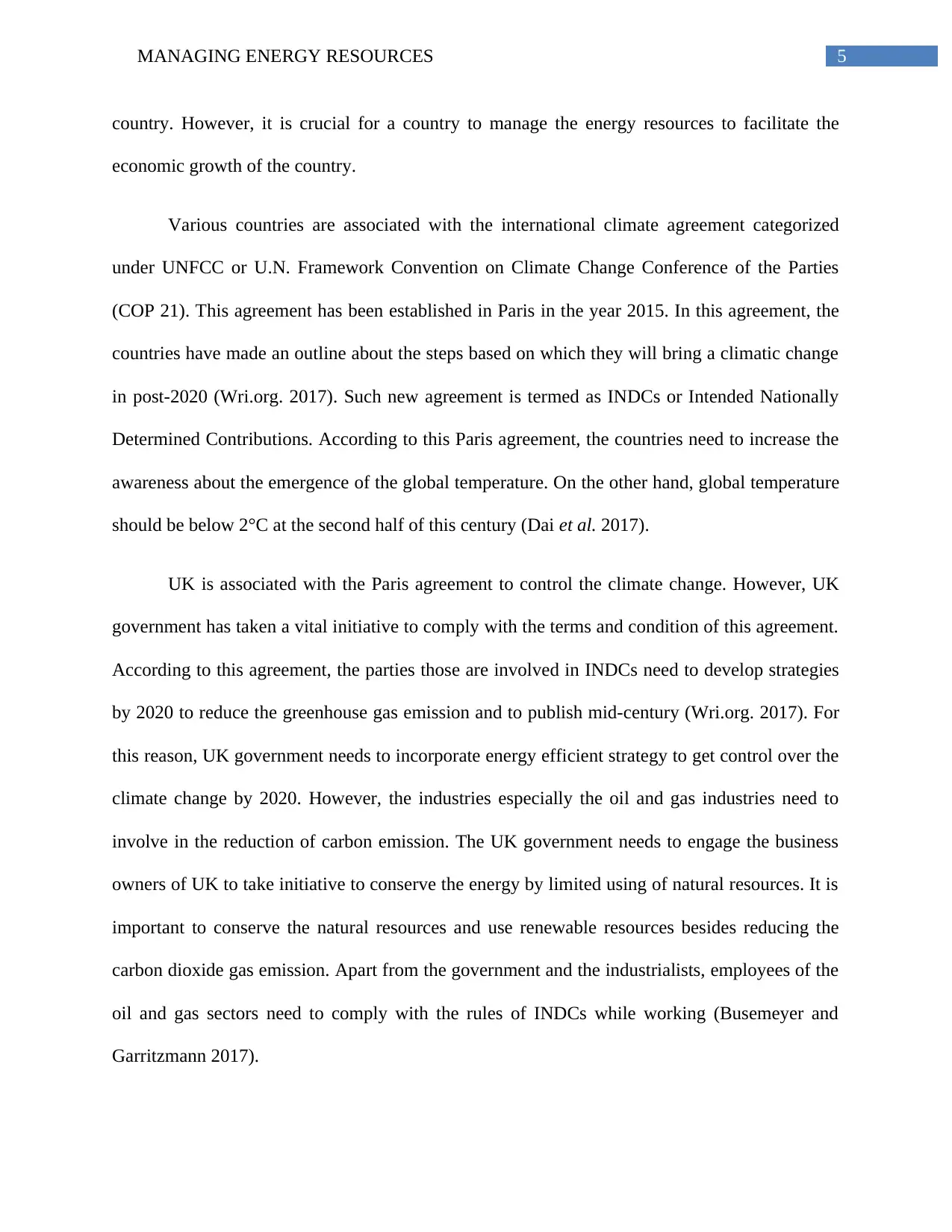
5MANAGING ENERGY RESOURCES
country. However, it is crucial for a country to manage the energy resources to facilitate the
economic growth of the country.
Various countries are associated with the international climate agreement categorized
under UNFCC or U.N. Framework Convention on Climate Change Conference of the Parties
(COP 21). This agreement has been established in Paris in the year 2015. In this agreement, the
countries have made an outline about the steps based on which they will bring a climatic change
in post-2020 (Wri.org. 2017). Such new agreement is termed as INDCs or Intended Nationally
Determined Contributions. According to this Paris agreement, the countries need to increase the
awareness about the emergence of the global temperature. On the other hand, global temperature
should be below 2°C at the second half of this century (Dai et al. 2017).
UK is associated with the Paris agreement to control the climate change. However, UK
government has taken a vital initiative to comply with the terms and condition of this agreement.
According to this agreement, the parties those are involved in INDCs need to develop strategies
by 2020 to reduce the greenhouse gas emission and to publish mid-century (Wri.org. 2017). For
this reason, UK government needs to incorporate energy efficient strategy to get control over the
climate change by 2020. However, the industries especially the oil and gas industries need to
involve in the reduction of carbon emission. The UK government needs to engage the business
owners of UK to take initiative to conserve the energy by limited using of natural resources. It is
important to conserve the natural resources and use renewable resources besides reducing the
carbon dioxide gas emission. Apart from the government and the industrialists, employees of the
oil and gas sectors need to comply with the rules of INDCs while working (Busemeyer and
Garritzmann 2017).
country. However, it is crucial for a country to manage the energy resources to facilitate the
economic growth of the country.
Various countries are associated with the international climate agreement categorized
under UNFCC or U.N. Framework Convention on Climate Change Conference of the Parties
(COP 21). This agreement has been established in Paris in the year 2015. In this agreement, the
countries have made an outline about the steps based on which they will bring a climatic change
in post-2020 (Wri.org. 2017). Such new agreement is termed as INDCs or Intended Nationally
Determined Contributions. According to this Paris agreement, the countries need to increase the
awareness about the emergence of the global temperature. On the other hand, global temperature
should be below 2°C at the second half of this century (Dai et al. 2017).
UK is associated with the Paris agreement to control the climate change. However, UK
government has taken a vital initiative to comply with the terms and condition of this agreement.
According to this agreement, the parties those are involved in INDCs need to develop strategies
by 2020 to reduce the greenhouse gas emission and to publish mid-century (Wri.org. 2017). For
this reason, UK government needs to incorporate energy efficient strategy to get control over the
climate change by 2020. However, the industries especially the oil and gas industries need to
involve in the reduction of carbon emission. The UK government needs to engage the business
owners of UK to take initiative to conserve the energy by limited using of natural resources. It is
important to conserve the natural resources and use renewable resources besides reducing the
carbon dioxide gas emission. Apart from the government and the industrialists, employees of the
oil and gas sectors need to comply with the rules of INDCs while working (Busemeyer and
Garritzmann 2017).
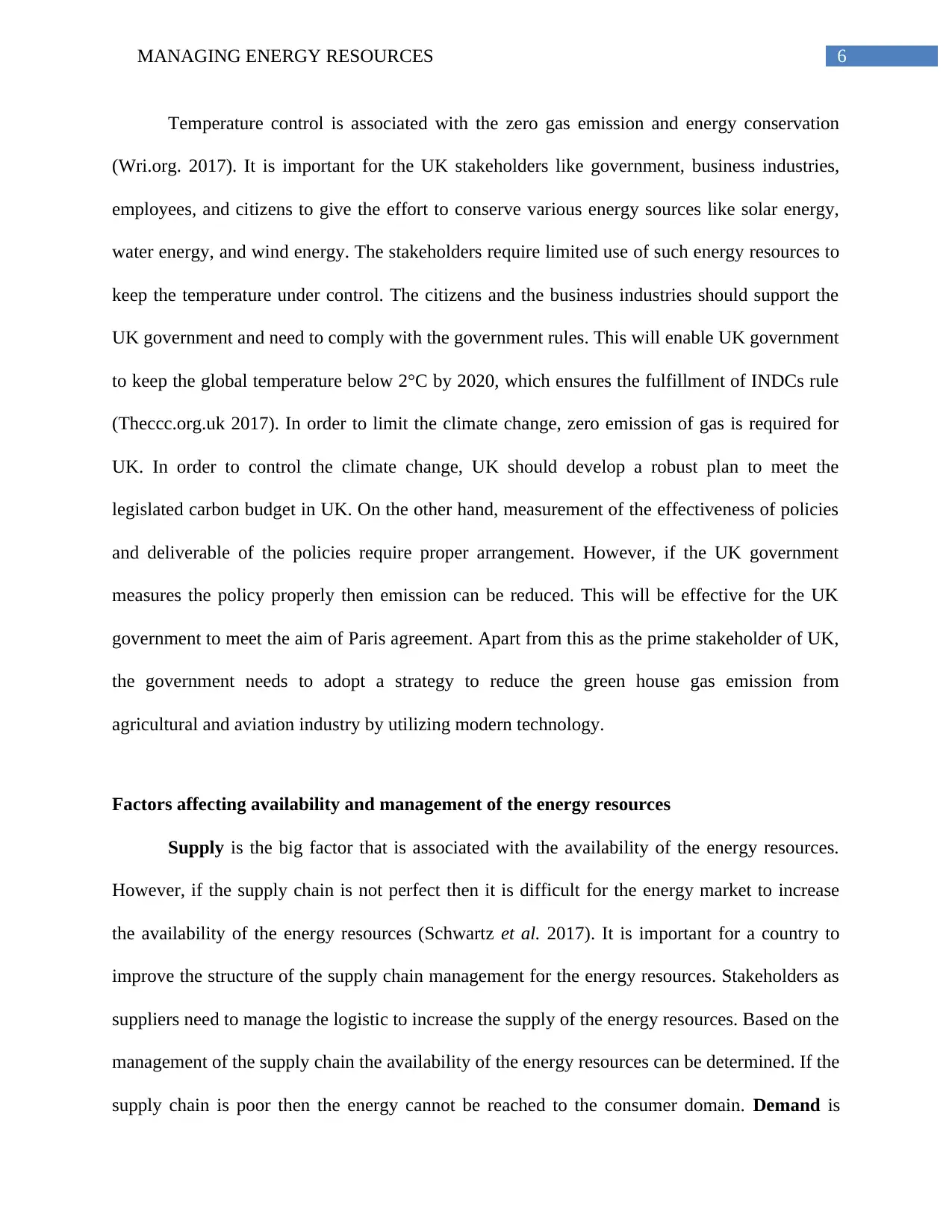
6MANAGING ENERGY RESOURCES
Temperature control is associated with the zero gas emission and energy conservation
(Wri.org. 2017). It is important for the UK stakeholders like government, business industries,
employees, and citizens to give the effort to conserve various energy sources like solar energy,
water energy, and wind energy. The stakeholders require limited use of such energy resources to
keep the temperature under control. The citizens and the business industries should support the
UK government and need to comply with the government rules. This will enable UK government
to keep the global temperature below 2°C by 2020, which ensures the fulfillment of INDCs rule
(Theccc.org.uk 2017). In order to limit the climate change, zero emission of gas is required for
UK. In order to control the climate change, UK should develop a robust plan to meet the
legislated carbon budget in UK. On the other hand, measurement of the effectiveness of policies
and deliverable of the policies require proper arrangement. However, if the UK government
measures the policy properly then emission can be reduced. This will be effective for the UK
government to meet the aim of Paris agreement. Apart from this as the prime stakeholder of UK,
the government needs to adopt a strategy to reduce the green house gas emission from
agricultural and aviation industry by utilizing modern technology.
Factors affecting availability and management of the energy resources
Supply is the big factor that is associated with the availability of the energy resources.
However, if the supply chain is not perfect then it is difficult for the energy market to increase
the availability of the energy resources (Schwartz et al. 2017). It is important for a country to
improve the structure of the supply chain management for the energy resources. Stakeholders as
suppliers need to manage the logistic to increase the supply of the energy resources. Based on the
management of the supply chain the availability of the energy resources can be determined. If the
supply chain is poor then the energy cannot be reached to the consumer domain. Demand is
Temperature control is associated with the zero gas emission and energy conservation
(Wri.org. 2017). It is important for the UK stakeholders like government, business industries,
employees, and citizens to give the effort to conserve various energy sources like solar energy,
water energy, and wind energy. The stakeholders require limited use of such energy resources to
keep the temperature under control. The citizens and the business industries should support the
UK government and need to comply with the government rules. This will enable UK government
to keep the global temperature below 2°C by 2020, which ensures the fulfillment of INDCs rule
(Theccc.org.uk 2017). In order to limit the climate change, zero emission of gas is required for
UK. In order to control the climate change, UK should develop a robust plan to meet the
legislated carbon budget in UK. On the other hand, measurement of the effectiveness of policies
and deliverable of the policies require proper arrangement. However, if the UK government
measures the policy properly then emission can be reduced. This will be effective for the UK
government to meet the aim of Paris agreement. Apart from this as the prime stakeholder of UK,
the government needs to adopt a strategy to reduce the green house gas emission from
agricultural and aviation industry by utilizing modern technology.
Factors affecting availability and management of the energy resources
Supply is the big factor that is associated with the availability of the energy resources.
However, if the supply chain is not perfect then it is difficult for the energy market to increase
the availability of the energy resources (Schwartz et al. 2017). It is important for a country to
improve the structure of the supply chain management for the energy resources. Stakeholders as
suppliers need to manage the logistic to increase the supply of the energy resources. Based on the
management of the supply chain the availability of the energy resources can be determined. If the
supply chain is poor then the energy cannot be reached to the consumer domain. Demand is
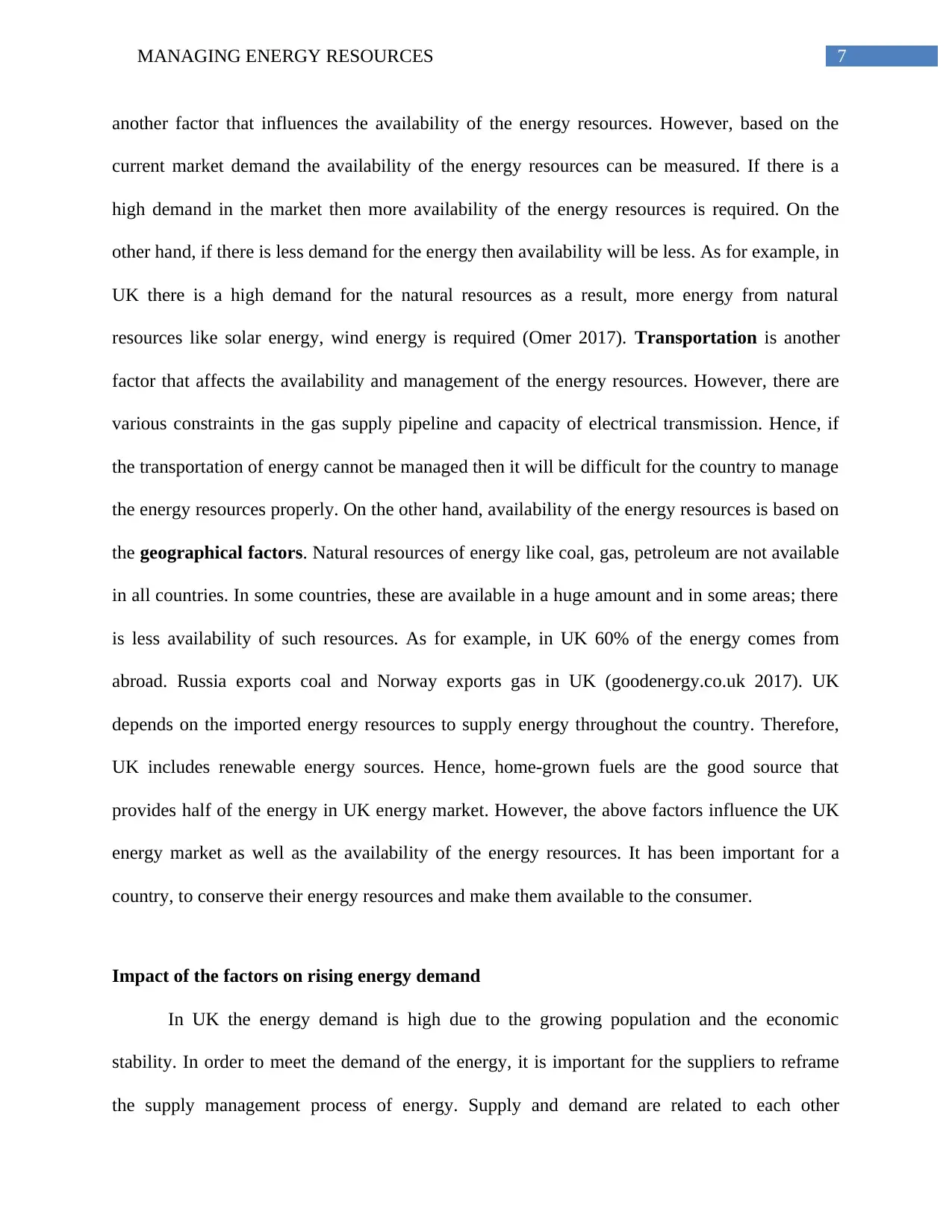
7MANAGING ENERGY RESOURCES
another factor that influences the availability of the energy resources. However, based on the
current market demand the availability of the energy resources can be measured. If there is a
high demand in the market then more availability of the energy resources is required. On the
other hand, if there is less demand for the energy then availability will be less. As for example, in
UK there is a high demand for the natural resources as a result, more energy from natural
resources like solar energy, wind energy is required (Omer 2017). Transportation is another
factor that affects the availability and management of the energy resources. However, there are
various constraints in the gas supply pipeline and capacity of electrical transmission. Hence, if
the transportation of energy cannot be managed then it will be difficult for the country to manage
the energy resources properly. On the other hand, availability of the energy resources is based on
the geographical factors. Natural resources of energy like coal, gas, petroleum are not available
in all countries. In some countries, these are available in a huge amount and in some areas; there
is less availability of such resources. As for example, in UK 60% of the energy comes from
abroad. Russia exports coal and Norway exports gas in UK (goodenergy.co.uk 2017). UK
depends on the imported energy resources to supply energy throughout the country. Therefore,
UK includes renewable energy sources. Hence, home-grown fuels are the good source that
provides half of the energy in UK energy market. However, the above factors influence the UK
energy market as well as the availability of the energy resources. It has been important for a
country, to conserve their energy resources and make them available to the consumer.
Impact of the factors on rising energy demand
In UK the energy demand is high due to the growing population and the economic
stability. In order to meet the demand of the energy, it is important for the suppliers to reframe
the supply management process of energy. Supply and demand are related to each other
another factor that influences the availability of the energy resources. However, based on the
current market demand the availability of the energy resources can be measured. If there is a
high demand in the market then more availability of the energy resources is required. On the
other hand, if there is less demand for the energy then availability will be less. As for example, in
UK there is a high demand for the natural resources as a result, more energy from natural
resources like solar energy, wind energy is required (Omer 2017). Transportation is another
factor that affects the availability and management of the energy resources. However, there are
various constraints in the gas supply pipeline and capacity of electrical transmission. Hence, if
the transportation of energy cannot be managed then it will be difficult for the country to manage
the energy resources properly. On the other hand, availability of the energy resources is based on
the geographical factors. Natural resources of energy like coal, gas, petroleum are not available
in all countries. In some countries, these are available in a huge amount and in some areas; there
is less availability of such resources. As for example, in UK 60% of the energy comes from
abroad. Russia exports coal and Norway exports gas in UK (goodenergy.co.uk 2017). UK
depends on the imported energy resources to supply energy throughout the country. Therefore,
UK includes renewable energy sources. Hence, home-grown fuels are the good source that
provides half of the energy in UK energy market. However, the above factors influence the UK
energy market as well as the availability of the energy resources. It has been important for a
country, to conserve their energy resources and make them available to the consumer.
Impact of the factors on rising energy demand
In UK the energy demand is high due to the growing population and the economic
stability. In order to meet the demand of the energy, it is important for the suppliers to reframe
the supply management process of energy. Supply and demand are related to each other
Paraphrase This Document
Need a fresh take? Get an instant paraphrase of this document with our AI Paraphraser
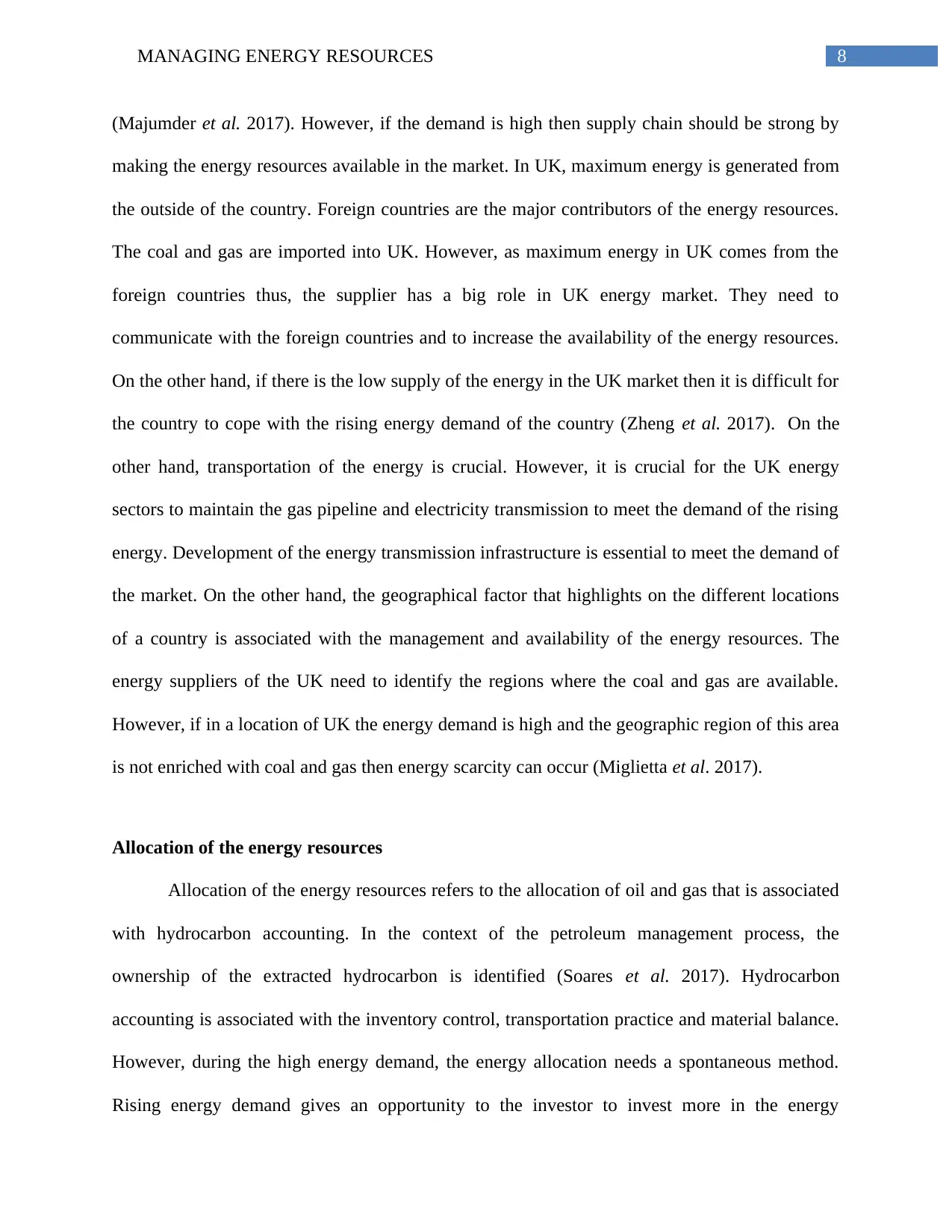
8MANAGING ENERGY RESOURCES
(Majumder et al. 2017). However, if the demand is high then supply chain should be strong by
making the energy resources available in the market. In UK, maximum energy is generated from
the outside of the country. Foreign countries are the major contributors of the energy resources.
The coal and gas are imported into UK. However, as maximum energy in UK comes from the
foreign countries thus, the supplier has a big role in UK energy market. They need to
communicate with the foreign countries and to increase the availability of the energy resources.
On the other hand, if there is the low supply of the energy in the UK market then it is difficult for
the country to cope with the rising energy demand of the country (Zheng et al. 2017). On the
other hand, transportation of the energy is crucial. However, it is crucial for the UK energy
sectors to maintain the gas pipeline and electricity transmission to meet the demand of the rising
energy. Development of the energy transmission infrastructure is essential to meet the demand of
the market. On the other hand, the geographical factor that highlights on the different locations
of a country is associated with the management and availability of the energy resources. The
energy suppliers of the UK need to identify the regions where the coal and gas are available.
However, if in a location of UK the energy demand is high and the geographic region of this area
is not enriched with coal and gas then energy scarcity can occur (Miglietta et al. 2017).
Allocation of the energy resources
Allocation of the energy resources refers to the allocation of oil and gas that is associated
with hydrocarbon accounting. In the context of the petroleum management process, the
ownership of the extracted hydrocarbon is identified (Soares et al. 2017). Hydrocarbon
accounting is associated with the inventory control, transportation practice and material balance.
However, during the high energy demand, the energy allocation needs a spontaneous method.
Rising energy demand gives an opportunity to the investor to invest more in the energy
(Majumder et al. 2017). However, if the demand is high then supply chain should be strong by
making the energy resources available in the market. In UK, maximum energy is generated from
the outside of the country. Foreign countries are the major contributors of the energy resources.
The coal and gas are imported into UK. However, as maximum energy in UK comes from the
foreign countries thus, the supplier has a big role in UK energy market. They need to
communicate with the foreign countries and to increase the availability of the energy resources.
On the other hand, if there is the low supply of the energy in the UK market then it is difficult for
the country to cope with the rising energy demand of the country (Zheng et al. 2017). On the
other hand, transportation of the energy is crucial. However, it is crucial for the UK energy
sectors to maintain the gas pipeline and electricity transmission to meet the demand of the rising
energy. Development of the energy transmission infrastructure is essential to meet the demand of
the market. On the other hand, the geographical factor that highlights on the different locations
of a country is associated with the management and availability of the energy resources. The
energy suppliers of the UK need to identify the regions where the coal and gas are available.
However, if in a location of UK the energy demand is high and the geographic region of this area
is not enriched with coal and gas then energy scarcity can occur (Miglietta et al. 2017).
Allocation of the energy resources
Allocation of the energy resources refers to the allocation of oil and gas that is associated
with hydrocarbon accounting. In the context of the petroleum management process, the
ownership of the extracted hydrocarbon is identified (Soares et al. 2017). Hydrocarbon
accounting is associated with the inventory control, transportation practice and material balance.
However, during the high energy demand, the energy allocation needs a spontaneous method.
Rising energy demand gives an opportunity to the investor to invest more in the energy
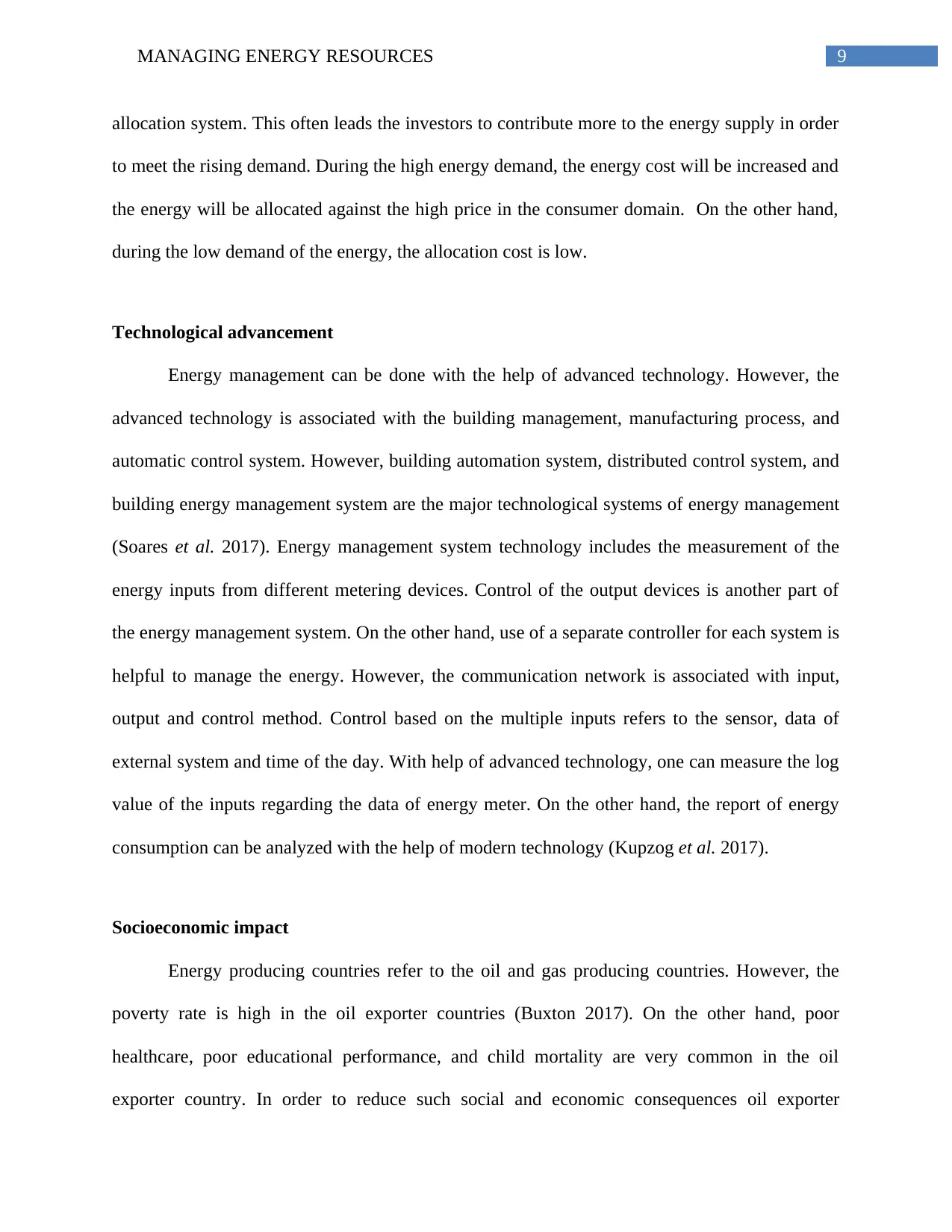
9MANAGING ENERGY RESOURCES
allocation system. This often leads the investors to contribute more to the energy supply in order
to meet the rising demand. During the high energy demand, the energy cost will be increased and
the energy will be allocated against the high price in the consumer domain. On the other hand,
during the low demand of the energy, the allocation cost is low.
Technological advancement
Energy management can be done with the help of advanced technology. However, the
advanced technology is associated with the building management, manufacturing process, and
automatic control system. However, building automation system, distributed control system, and
building energy management system are the major technological systems of energy management
(Soares et al. 2017). Energy management system technology includes the measurement of the
energy inputs from different metering devices. Control of the output devices is another part of
the energy management system. On the other hand, use of a separate controller for each system is
helpful to manage the energy. However, the communication network is associated with input,
output and control method. Control based on the multiple inputs refers to the sensor, data of
external system and time of the day. With help of advanced technology, one can measure the log
value of the inputs regarding the data of energy meter. On the other hand, the report of energy
consumption can be analyzed with the help of modern technology (Kupzog et al. 2017).
Socioeconomic impact
Energy producing countries refer to the oil and gas producing countries. However, the
poverty rate is high in the oil exporter countries (Buxton 2017). On the other hand, poor
healthcare, poor educational performance, and child mortality are very common in the oil
exporter country. In order to reduce such social and economic consequences oil exporter
allocation system. This often leads the investors to contribute more to the energy supply in order
to meet the rising demand. During the high energy demand, the energy cost will be increased and
the energy will be allocated against the high price in the consumer domain. On the other hand,
during the low demand of the energy, the allocation cost is low.
Technological advancement
Energy management can be done with the help of advanced technology. However, the
advanced technology is associated with the building management, manufacturing process, and
automatic control system. However, building automation system, distributed control system, and
building energy management system are the major technological systems of energy management
(Soares et al. 2017). Energy management system technology includes the measurement of the
energy inputs from different metering devices. Control of the output devices is another part of
the energy management system. On the other hand, use of a separate controller for each system is
helpful to manage the energy. However, the communication network is associated with input,
output and control method. Control based on the multiple inputs refers to the sensor, data of
external system and time of the day. With help of advanced technology, one can measure the log
value of the inputs regarding the data of energy meter. On the other hand, the report of energy
consumption can be analyzed with the help of modern technology (Kupzog et al. 2017).
Socioeconomic impact
Energy producing countries refer to the oil and gas producing countries. However, the
poverty rate is high in the oil exporter countries (Buxton 2017). On the other hand, poor
healthcare, poor educational performance, and child mortality are very common in the oil
exporter country. In order to reduce such social and economic consequences oil exporter
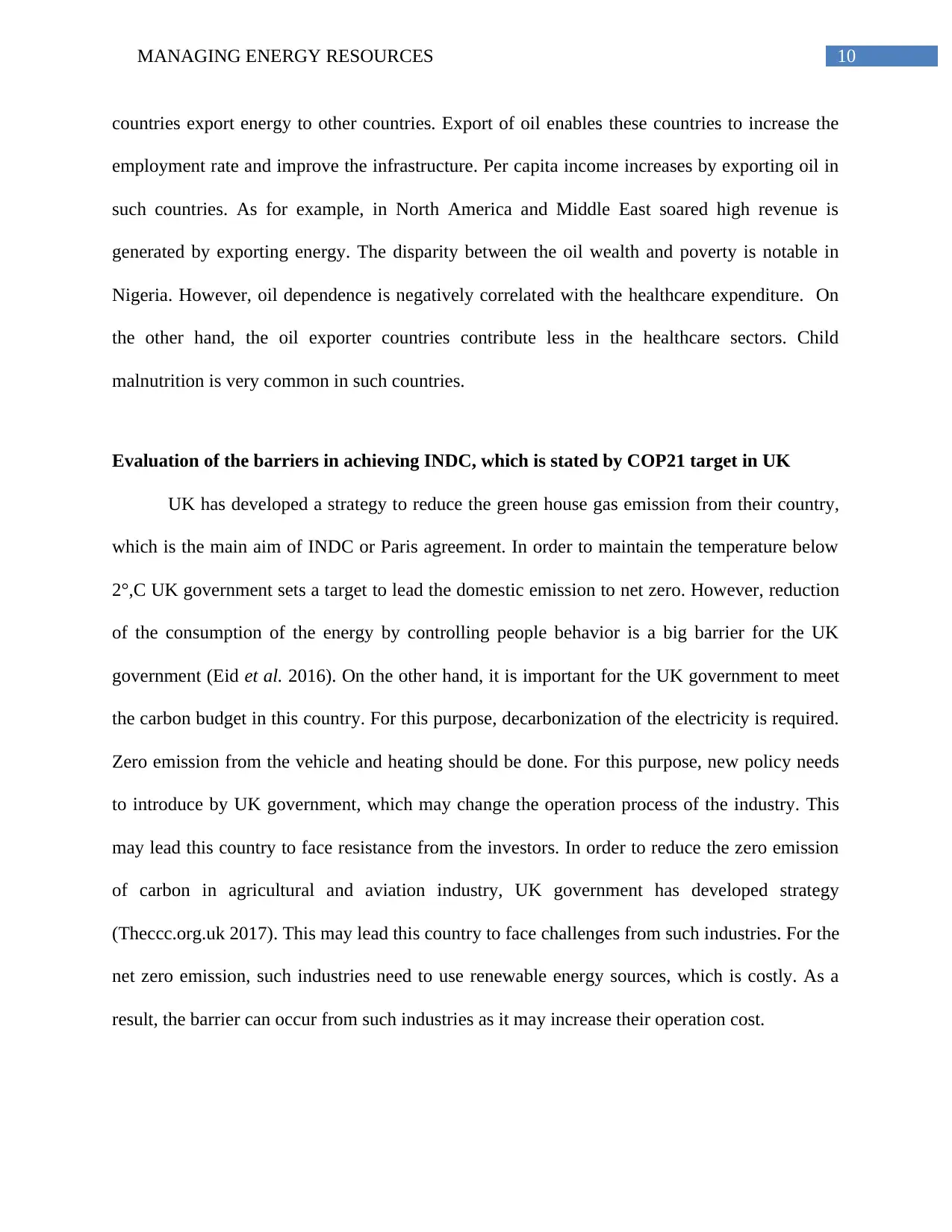
10MANAGING ENERGY RESOURCES
countries export energy to other countries. Export of oil enables these countries to increase the
employment rate and improve the infrastructure. Per capita income increases by exporting oil in
such countries. As for example, in North America and Middle East soared high revenue is
generated by exporting energy. The disparity between the oil wealth and poverty is notable in
Nigeria. However, oil dependence is negatively correlated with the healthcare expenditure. On
the other hand, the oil exporter countries contribute less in the healthcare sectors. Child
malnutrition is very common in such countries.
Evaluation of the barriers in achieving INDC, which is stated by COP21 target in UK
UK has developed a strategy to reduce the green house gas emission from their country,
which is the main aim of INDC or Paris agreement. In order to maintain the temperature below
2°,C UK government sets a target to lead the domestic emission to net zero. However, reduction
of the consumption of the energy by controlling people behavior is a big barrier for the UK
government (Eid et al. 2016). On the other hand, it is important for the UK government to meet
the carbon budget in this country. For this purpose, decarbonization of the electricity is required.
Zero emission from the vehicle and heating should be done. For this purpose, new policy needs
to introduce by UK government, which may change the operation process of the industry. This
may lead this country to face resistance from the investors. In order to reduce the zero emission
of carbon in agricultural and aviation industry, UK government has developed strategy
(Theccc.org.uk 2017). This may lead this country to face challenges from such industries. For the
net zero emission, such industries need to use renewable energy sources, which is costly. As a
result, the barrier can occur from such industries as it may increase their operation cost.
countries export energy to other countries. Export of oil enables these countries to increase the
employment rate and improve the infrastructure. Per capita income increases by exporting oil in
such countries. As for example, in North America and Middle East soared high revenue is
generated by exporting energy. The disparity between the oil wealth and poverty is notable in
Nigeria. However, oil dependence is negatively correlated with the healthcare expenditure. On
the other hand, the oil exporter countries contribute less in the healthcare sectors. Child
malnutrition is very common in such countries.
Evaluation of the barriers in achieving INDC, which is stated by COP21 target in UK
UK has developed a strategy to reduce the green house gas emission from their country,
which is the main aim of INDC or Paris agreement. In order to maintain the temperature below
2°,C UK government sets a target to lead the domestic emission to net zero. However, reduction
of the consumption of the energy by controlling people behavior is a big barrier for the UK
government (Eid et al. 2016). On the other hand, it is important for the UK government to meet
the carbon budget in this country. For this purpose, decarbonization of the electricity is required.
Zero emission from the vehicle and heating should be done. For this purpose, new policy needs
to introduce by UK government, which may change the operation process of the industry. This
may lead this country to face resistance from the investors. In order to reduce the zero emission
of carbon in agricultural and aviation industry, UK government has developed strategy
(Theccc.org.uk 2017). This may lead this country to face challenges from such industries. For the
net zero emission, such industries need to use renewable energy sources, which is costly. As a
result, the barrier can occur from such industries as it may increase their operation cost.
Secure Best Marks with AI Grader
Need help grading? Try our AI Grader for instant feedback on your assignments.
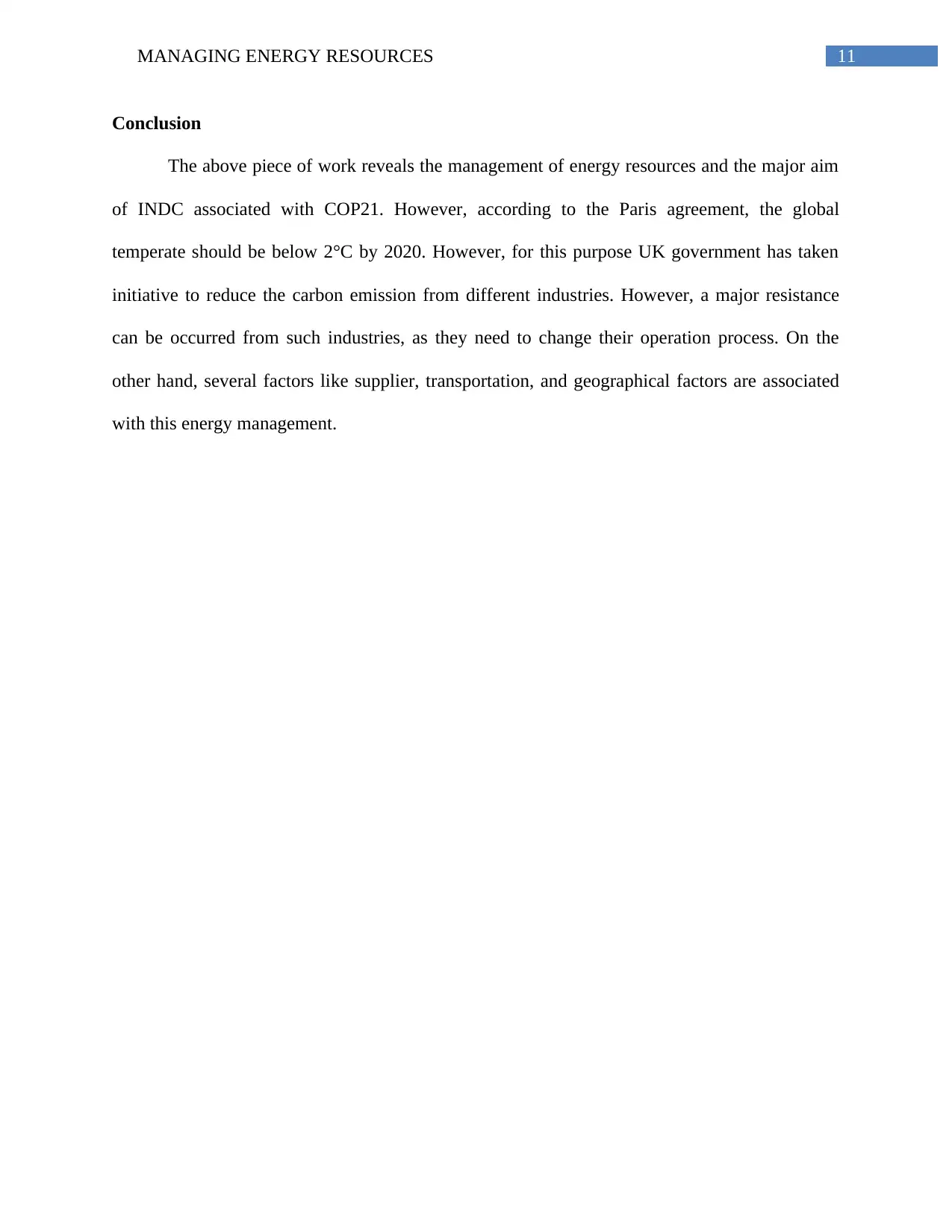
11MANAGING ENERGY RESOURCES
Conclusion
The above piece of work reveals the management of energy resources and the major aim
of INDC associated with COP21. However, according to the Paris agreement, the global
temperate should be below 2°C by 2020. However, for this purpose UK government has taken
initiative to reduce the carbon emission from different industries. However, a major resistance
can be occurred from such industries, as they need to change their operation process. On the
other hand, several factors like supplier, transportation, and geographical factors are associated
with this energy management.
Conclusion
The above piece of work reveals the management of energy resources and the major aim
of INDC associated with COP21. However, according to the Paris agreement, the global
temperate should be below 2°C by 2020. However, for this purpose UK government has taken
initiative to reduce the carbon emission from different industries. However, a major resistance
can be occurred from such industries, as they need to change their operation process. On the
other hand, several factors like supplier, transportation, and geographical factors are associated
with this energy management.
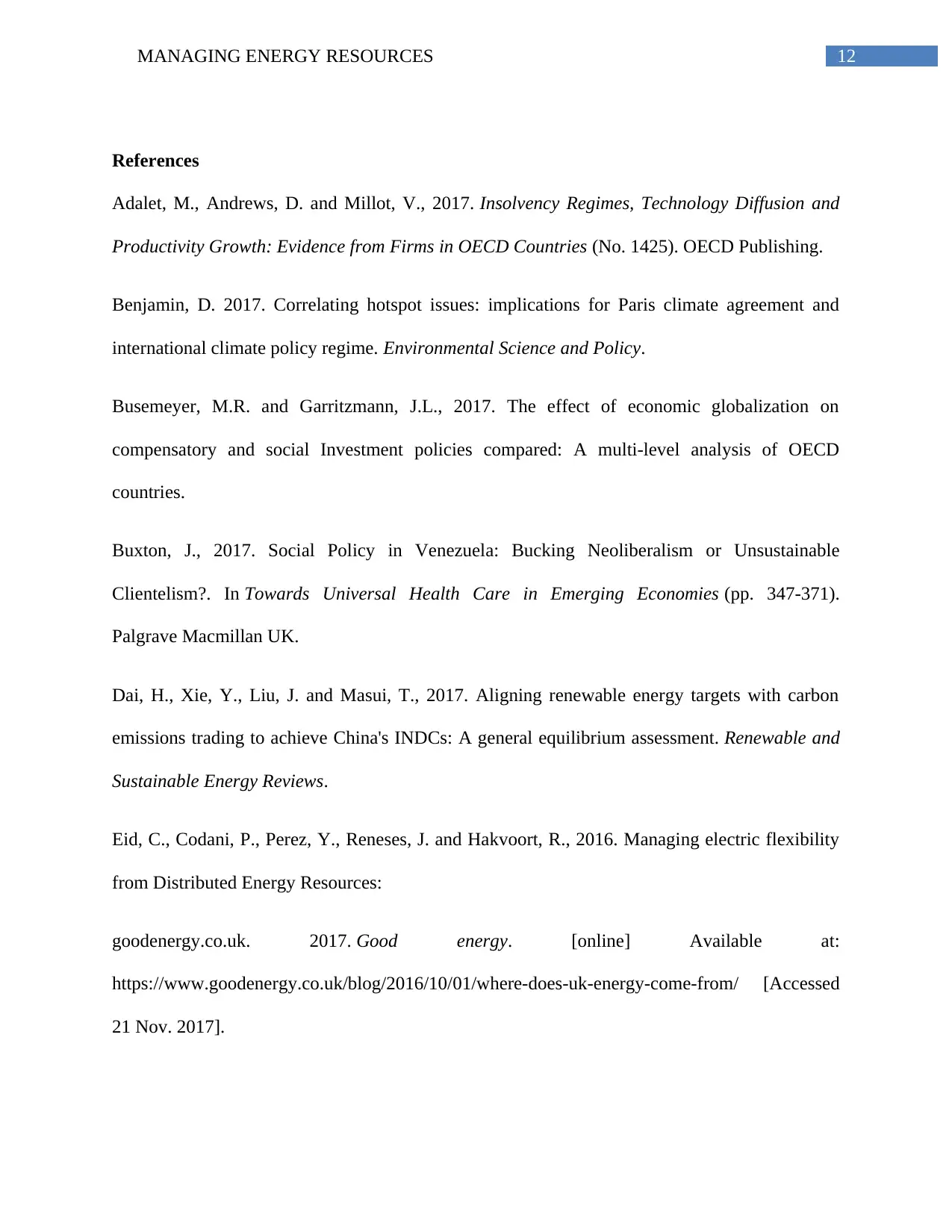
12MANAGING ENERGY RESOURCES
References
Adalet, M., Andrews, D. and Millot, V., 2017. Insolvency Regimes, Technology Diffusion and
Productivity Growth: Evidence from Firms in OECD Countries (No. 1425). OECD Publishing.
Benjamin, D. 2017. Correlating hotspot issues: implications for Paris climate agreement and
international climate policy regime. Environmental Science and Policy.
Busemeyer, M.R. and Garritzmann, J.L., 2017. The effect of economic globalization on
compensatory and social Investment policies compared: A multi-level analysis of OECD
countries.
Buxton, J., 2017. Social Policy in Venezuela: Bucking Neoliberalism or Unsustainable
Clientelism?. In Towards Universal Health Care in Emerging Economies (pp. 347-371).
Palgrave Macmillan UK.
Dai, H., Xie, Y., Liu, J. and Masui, T., 2017. Aligning renewable energy targets with carbon
emissions trading to achieve China's INDCs: A general equilibrium assessment. Renewable and
Sustainable Energy Reviews.
Eid, C., Codani, P., Perez, Y., Reneses, J. and Hakvoort, R., 2016. Managing electric flexibility
from Distributed Energy Resources:
goodenergy.co.uk. 2017. Good energy. [online] Available at:
https://www.goodenergy.co.uk/blog/2016/10/01/where-does-uk-energy-come-from/ [Accessed
21 Nov. 2017].
References
Adalet, M., Andrews, D. and Millot, V., 2017. Insolvency Regimes, Technology Diffusion and
Productivity Growth: Evidence from Firms in OECD Countries (No. 1425). OECD Publishing.
Benjamin, D. 2017. Correlating hotspot issues: implications for Paris climate agreement and
international climate policy regime. Environmental Science and Policy.
Busemeyer, M.R. and Garritzmann, J.L., 2017. The effect of economic globalization on
compensatory and social Investment policies compared: A multi-level analysis of OECD
countries.
Buxton, J., 2017. Social Policy in Venezuela: Bucking Neoliberalism or Unsustainable
Clientelism?. In Towards Universal Health Care in Emerging Economies (pp. 347-371).
Palgrave Macmillan UK.
Dai, H., Xie, Y., Liu, J. and Masui, T., 2017. Aligning renewable energy targets with carbon
emissions trading to achieve China's INDCs: A general equilibrium assessment. Renewable and
Sustainable Energy Reviews.
Eid, C., Codani, P., Perez, Y., Reneses, J. and Hakvoort, R., 2016. Managing electric flexibility
from Distributed Energy Resources:
goodenergy.co.uk. 2017. Good energy. [online] Available at:
https://www.goodenergy.co.uk/blog/2016/10/01/where-does-uk-energy-come-from/ [Accessed
21 Nov. 2017].
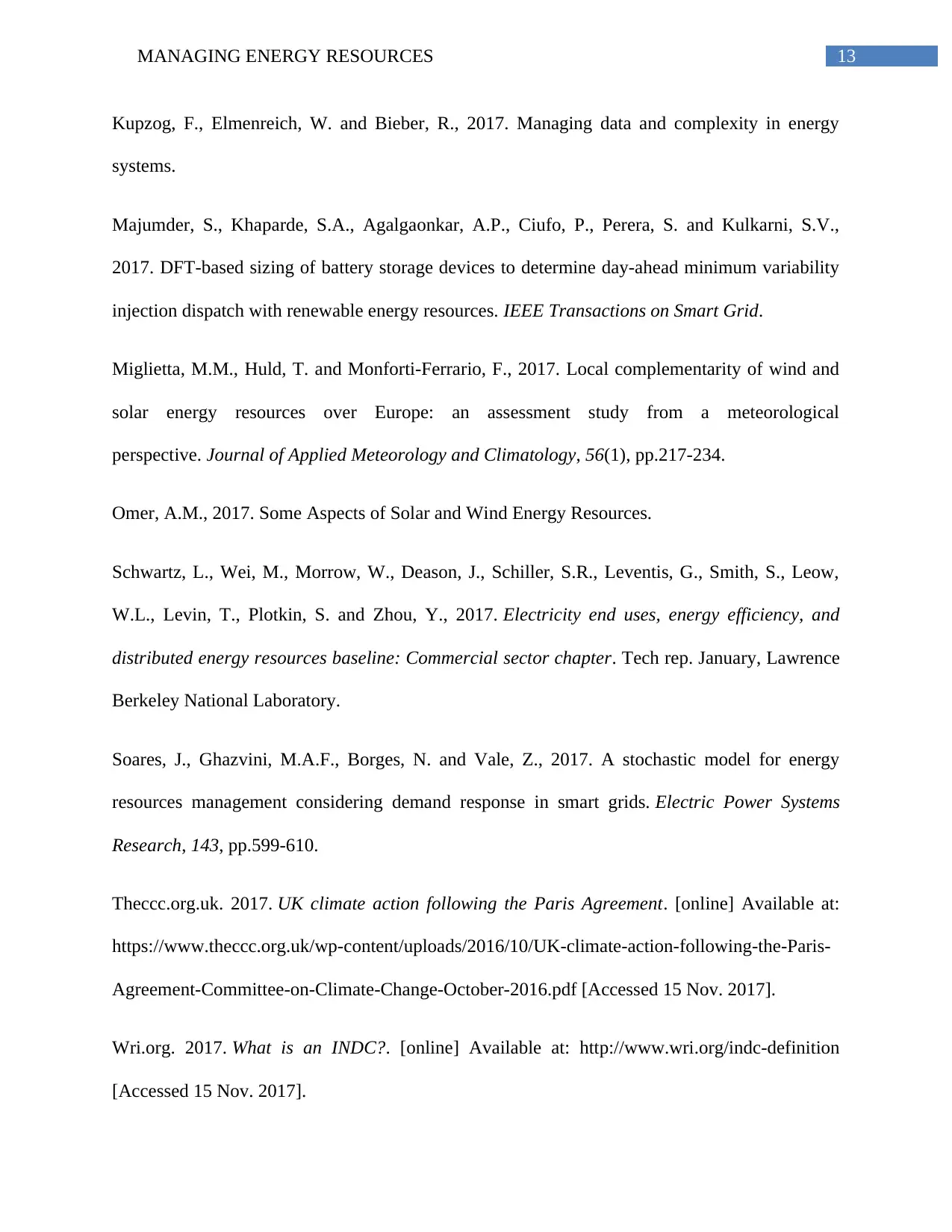
13MANAGING ENERGY RESOURCES
Kupzog, F., Elmenreich, W. and Bieber, R., 2017. Managing data and complexity in energy
systems.
Majumder, S., Khaparde, S.A., Agalgaonkar, A.P., Ciufo, P., Perera, S. and Kulkarni, S.V.,
2017. DFT-based sizing of battery storage devices to determine day-ahead minimum variability
injection dispatch with renewable energy resources. IEEE Transactions on Smart Grid.
Miglietta, M.M., Huld, T. and Monforti-Ferrario, F., 2017. Local complementarity of wind and
solar energy resources over Europe: an assessment study from a meteorological
perspective. Journal of Applied Meteorology and Climatology, 56(1), pp.217-234.
Omer, A.M., 2017. Some Aspects of Solar and Wind Energy Resources.
Schwartz, L., Wei, M., Morrow, W., Deason, J., Schiller, S.R., Leventis, G., Smith, S., Leow,
W.L., Levin, T., Plotkin, S. and Zhou, Y., 2017. Electricity end uses, energy efficiency, and
distributed energy resources baseline: Commercial sector chapter. Tech rep. January, Lawrence
Berkeley National Laboratory.
Soares, J., Ghazvini, M.A.F., Borges, N. and Vale, Z., 2017. A stochastic model for energy
resources management considering demand response in smart grids. Electric Power Systems
Research, 143, pp.599-610.
Theccc.org.uk. 2017. UK climate action following the Paris Agreement. [online] Available at:
https://www.theccc.org.uk/wp-content/uploads/2016/10/UK-climate-action-following-the-Paris-
Agreement-Committee-on-Climate-Change-October-2016.pdf [Accessed 15 Nov. 2017].
Wri.org. 2017. What is an INDC?. [online] Available at: http://www.wri.org/indc-definition
[Accessed 15 Nov. 2017].
Kupzog, F., Elmenreich, W. and Bieber, R., 2017. Managing data and complexity in energy
systems.
Majumder, S., Khaparde, S.A., Agalgaonkar, A.P., Ciufo, P., Perera, S. and Kulkarni, S.V.,
2017. DFT-based sizing of battery storage devices to determine day-ahead minimum variability
injection dispatch with renewable energy resources. IEEE Transactions on Smart Grid.
Miglietta, M.M., Huld, T. and Monforti-Ferrario, F., 2017. Local complementarity of wind and
solar energy resources over Europe: an assessment study from a meteorological
perspective. Journal of Applied Meteorology and Climatology, 56(1), pp.217-234.
Omer, A.M., 2017. Some Aspects of Solar and Wind Energy Resources.
Schwartz, L., Wei, M., Morrow, W., Deason, J., Schiller, S.R., Leventis, G., Smith, S., Leow,
W.L., Levin, T., Plotkin, S. and Zhou, Y., 2017. Electricity end uses, energy efficiency, and
distributed energy resources baseline: Commercial sector chapter. Tech rep. January, Lawrence
Berkeley National Laboratory.
Soares, J., Ghazvini, M.A.F., Borges, N. and Vale, Z., 2017. A stochastic model for energy
resources management considering demand response in smart grids. Electric Power Systems
Research, 143, pp.599-610.
Theccc.org.uk. 2017. UK climate action following the Paris Agreement. [online] Available at:
https://www.theccc.org.uk/wp-content/uploads/2016/10/UK-climate-action-following-the-Paris-
Agreement-Committee-on-Climate-Change-October-2016.pdf [Accessed 15 Nov. 2017].
Wri.org. 2017. What is an INDC?. [online] Available at: http://www.wri.org/indc-definition
[Accessed 15 Nov. 2017].
Paraphrase This Document
Need a fresh take? Get an instant paraphrase of this document with our AI Paraphraser

14MANAGING ENERGY RESOURCES
Zheng, C.W., Wang, Q. and Li, C.Y., 2017. An overview of medium-to long-term predictions of
global wave energy resources. Renewable and Sustainable Energy Reviews, 79, pp.14
Zheng, C.W., Wang, Q. and Li, C.Y., 2017. An overview of medium-to long-term predictions of
global wave energy resources. Renewable and Sustainable Energy Reviews, 79, pp.14
1 out of 14
Related Documents
Your All-in-One AI-Powered Toolkit for Academic Success.
+13062052269
info@desklib.com
Available 24*7 on WhatsApp / Email
![[object Object]](/_next/static/media/star-bottom.7253800d.svg)
Unlock your academic potential
© 2024 | Zucol Services PVT LTD | All rights reserved.





